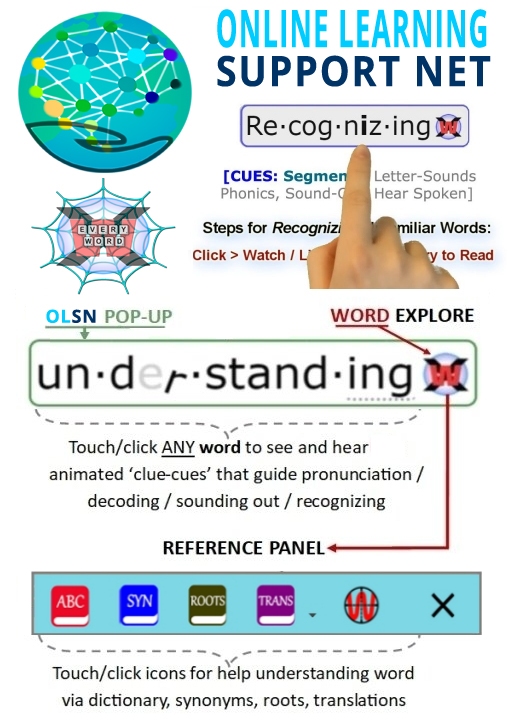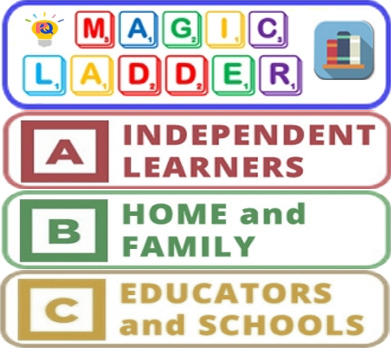Instructional Confusion
Note: Remember to click on any word on this page to experience the next evolutionary step in technology supported reading.
Instructional Casualties
When we look at the kids who are having a tough time learning to read and we went through the statistics, thirty-eight percent nationally, disaggregate that, seventy percent of kids from poverty and so forth hit the wall. Ninety-five of those kids are instructional casualties. About five to six percent of those kids have what we call dyslexia or learning disabilities in reading. Ninety-five percent of the kids hitting the wall in learning to read are what we call NBT: Never Been Taught. They’ve probably been with teachers where the heart was in the right place, they’ve been with teachers who wanted the best for the kids, but they have been with teachers who cannot answer the questions: 1) What goes into reading, what does it take? 2) Why do some kids have difficulty? 3) How can we identify kids early and prevent it? 4) How can we remediate it?
G. Reid Lyon, Past- Chief of the Child Development and Behavior Branch of the National Institute of Child Health & Human Development, National Institutes of Health, Current senior vice president for research and evaluation with Best Associates. Source: COTC Interview – http://www.childrenofthecode.org/interviews/lyon.htm#Instructionalcasualties
Instructional Confusion
Third problem is instructional confusion. So, we have a difficult code, we have a neural system that for some children is not optimal for dealing with this code, and then we throw them an instructional system, a teaching system; teachers who don’t understand what the code really is or how it needs to be conveyed. And so the teacher is suggesting you should do this when in fact the child should be doing that.
You can sample first or second grade classrooms around the country and you will still find, despite what we know about the process of reading and have learned over the past twenty years, you will still find that teachers for a first grader who is struggling to sound out a word who will discourage the child from doing that, and encourage the child to look at the pictures in the book and guess what that word means. Good readers don’t guess, good readers sound out almost every word on the page. And so the teacher is saying you solve the task this way when in fact the task has to be solved in an entirely different way. And that can not help but confuse children. So, non-optimal instruction, and in some cases simply misleading instruction, is a significant part of the problem.
Grover (Russ) Whitehurst, Ex-Director (2002-08), Institute of Education Sciences, U.S. Department of Education. Source: COTC Interview: http://www.childrenofthecode.org/interviews/whitehurst.htm#WhyisReadingsoDifficult
Insufficient Instructional Approaches
The fact of the matter is most of our kids at risk are kids who did not have these interactions that built the fundamental, foundational linguistic building blocks. They come into kindergarten, first grade, and if they then get instructional approaches that don’t take advantage of what we know about the code, if they get instructional approaches that are philosophically based, holistic and so forth, they’ll never get it. Because they’re coming for clarity, and if they’re expected to discover these kinds of things without all of those previous building blocks how are they going to do it? It’s like me being sat in front of a piano listening to Mozart without any musical background and then being expected to induce these things, expected to pick it up naturally. It just doesn’t happen. So, you’ve got all these kinds of cultural, instructional language things moving at one time, which all can be helped and adjudicated by just knowledge.
G. Reid Lyon, Past- Chief of the Child Development and Behavior Branch of the National Institute of Child Health & Human Development, National Institutes of Health, Current senior vice president for research and evaluation with Best Associates. Source: COTC Interview – http://www.childrenofthecode.org/interviews/lyon.htm#Necessaryinsufficient
Instructional Confusion 2
It’s arguable, and certainly in my position, that well designed instructional materials, by well designed I mean taking into account what we know about the code and how difficult it is, how to make it simpler and more transparent in particular stages in learning to read, well designed instructional materials, teachers who know how to support children as they are exposed to those instructional materials and periodic assessments so we know when children are falling behind. Standard packages of materials as preventive strategies may be sufficient to move us substantially ahead in terms of solving this problem. It will not get us the whole way, but it’s going to get us, I think, a long way there. One of the principle problems here is instructional confusion. If we can reduce that confusion we’re going to generate more successes in learning to read.
Grover (Russ) Whitehurst, Ex-Director (2002-08), Institute of Education Sciences, U.S. Department of Education. Source: COTC Interview: http://www.childrenofthecode.org/interviews/whitehurst.htm#SyncvsSystematicInstruct
Instructional Confusion
I sat in on a session that a colleague of mine was doing on phoneme grapheme mapping. She has designed an instructional procedure for phoneme grapheme mapping which is a nice little supplement for teachers. In the workshop I saw the same thing happening that I see all the time when I’m working with teachers which is the rather profound confusion that exists even among people who have degrees and certificates in reading instruction – how many aspects of the code are unclear to them and they go merrily along teaching their programs and teaching kids without ever resolving the questions that come up in a formal presentation. I saw this colleague of mine leading them through the phoneme grapheme mapping exercises and it was fun for me to see somebody else encountering the same questions and areas of confusion in the teacher audience that I experience all of the time.
The universality of those confusions was impressed on me again and how totally oblivious the teacher certification process is to equipping teachers with that knowledge base. Schools typically don’t take it on as a responsibility; they typically don’t teach it very well if they teach it at all. The instruction is not well conceived even if it is there. People leave those certification programs with the responsibility of teaching kids but without the tools to really make any of these English code issues clear to kids.
Louisa Moats, Director, Professional Development and Research Initiatives at Sopris West Educational Services; Author, Speech to Print: Language Essentials for Teachers, Parenting a Struggling Reader, and LETRS (Language Essentials for Teachers of Reading and Spelling). Source: COTC Interview: http://www.childrenofthecode.org/interviews/moats.htm#InstructionalConfusion
The Code Hasn't Been Seriously Taught
My humble opinion is the problem with learning the code is not really with the code, it’s with the teaching of the code. We have long periods in the history of reading instruction in America where the code wasn’t taught or was taught in such a boring, offensive or misleading way that it didn’t do much good. I could even be more extreme and say that teaching the code probably was a negative factor. Drilling kids to death on letter-sound correspondences probably is as bad as not teaching them at all. Or almost so.
So, the first problem that I see is that it’s difficult to find a time when the code was seriously taught and taught well. And I can’t explain why it is that even today there is such enormous resistance to deal with the code among the college faculty who teach reading methods to pre-service and in-service teachers.
Richard Venezky, Past Unidel Professor of Educational Studies and Professor of Computer and Information Sciences, and Linguistics at the University of Delaware. He is the author of The American Way of Spelling: The Structure and Origins of American English Orthography. Source: COTC Interview – http://www.childrenofthecode.org/interviews/venezky.htm#TheCode
Efficacy of Good Instruction
There’s good research that points to the dramatic efficacy of good instruction. It is true that not enough good instruction is getting to kids. Kids just don’t have the benefit of it. Teachers need to be trained in order to carry out the kind of instruction that is effective. And, there is good research to show that up to ninety-five percent or so of reading problems, reading difficulties can be effectively addressed if that instruction is there and delivered in the right way. That still leaves about four to six percent of the student population that is not responding, that is still struggling, that needs some other kind of intervention, some other kind of instruction.
And interestingly, the percentage of children in the school age population who have learning disabilities right now is about five percent. And they need even more intensive, individualized instruction in order to address their underlying problems. Not all the problems are going to be solved simply because we get classroom teachers up to a certain level.
James Wendorf, Executive Director, National Center for Learning Disabilities. Source: COTC Interview – http://www.childrenofthecode.org/interviews/wendorf.htm#InstructionalCasualities
Difference Between an Instructional Casualty and a Student with Neurobiological Disability
I think there is a difference between a student who is an ‘instructional casualty’; in other words, a student who has not flourished in the schools, who has not had access to the right kind of teaching, a student whom the schools have failed in some way. There’s a difference between that kind of student and a student with an underlying neurobiological disability. Learning disabilities are not acquired; they are there – they are life long – they are real. They can be expressed in any number of ways early on; they could appear later in a school career, even as late as high school or adulthood.
James Wendorf, Executive Director, National Center for Learning Disabilities. Source: COTC Interview – http://www.childrenofthecode.org/interviews/wendorf.htm#NeurobiologicalDeficienciesVsInstruc













